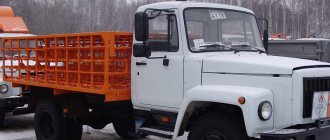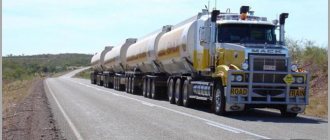Is it possible to transport
Transportation of gas containers by car is not prohibited by the rules. They need to be transported somehow. Whether it is possible to transport a gas cylinder in a car and how it is done correctly is described in ADR - the International Agreement on the Road Transport of Dangerous Goods and the "Rules for the Transportation of Dangerous Goods by Road", introduced by the Ministry of Transport in 1999.
In addition to the list of substances classified as hazardous, the rules also indicate the maximum permissible volumes. Having understood the nuances, it is easy to understand whether it is possible to transport a gas cylinder in the trunk of a car. Of course, this is permissible, but subject to a number of conditions.
The traffic rules state that the transportation of containers with gases must be carried out in accordance with accepted rules. And the Code of the Russian Federation on Administrative Violations provides for liability for their violation.
And one more important point is the technical condition and pressure testing of the cylinders themselves. For example, for HBO, once every 2 years it is necessary to undergo an examination procedure.
Is it possible to transport a propane tank in a car?
It is worth remembering that there are certain types of gas that are strictly prohibited from being transported on one vehicle. What kind of dangerous cargo (gas cylinders) can be transported by car with concessions? In fact, with some concessions, a lot of dangerous goods can be transported. The most common version is that dangerous goods can be transported without restrictions under clause 1.1.3.6.
Today, the traffic rules (clause 6.2) specify clear rules for the transportation of gas cylinders by road. This document defines the following provisions:
- Gas cylinders can only be transported if the containers, their plugs and fittings are in good condition.
If the car is intended to transport passengers, then problems may arise with the traffic police. The fact is that in this case, a contradiction appears between traffic rules and the requirements for the transportation of dangerous goods - it is impossible to separate the interior of a passenger Gazelle from the driver’s cabin, and according to the rules, the transportation of gas cylinders in the cabin is prohibited.
The transportation of gas cylinders by road, as well as propane and other hazardous substances, is regulated by the “Rules for the carriage of goods by road” and the international agreement ADR. The rules are stated there that the permitted volume of transportation, without complying with the usual conditions of ADR, is 333 liters.
Transportation rules
The rules for transporting gas cylinders by road do not apply to a limited number of containers in one vehicle. Containers containing gaseous substances may only be transported in a horizontal position. The gas containers themselves must have inscriptions with the name of the substance. Their maximum number is determined in the European Agreement concerning the International Carriage of Dangerous Goods by Road (ADR) in section 1.1.3.
Formally, the transportation of gas cylinders by road is not prohibited for private individuals if the containers are well-packed and all measures are taken to prevent leakage.
All gaseous substances are divided into categories. Not all gases are recognized as hazardous for transportation.
Gaseous substances belonging to different categories are prohibited from being transported in the same vehicle.
Having carefully studied the rules for transporting gas cylinders in a passenger car, we conclude that transportation is allowed:
- Up to five 50-liter pressure tanks with oxygen, argon, carbon dioxide, acetylene and propane, subject to specially equipped space. They should be in a container or on a wooden comb.
- More than 5 units, if the car is equipped for transporting goods recognized as dangerous, and the driver has undergone appropriate training and received a certificate.
Transportation of gas cylinders by road transport in the cabin is strictly prohibited. You can transport them in the trunk, subject to safety standards.
Smoking during transportation is prohibited. Brake sharply and stop near open flames too.
The vehicle must not be left unattended, and if there are signs of leakage, gas containers must be removed at least 100 meters from residential buildings.
Transporting propane in cylinders by road is associated with great risk. They should not be loaded with the valves facing down or while wearing dirty gloves. Propane and oxygen cannot be transported at the same time. It is absolutely necessary to prevent overheating above 45 degrees. Containers must be secured to a solid base, otherwise an explosion may occur.
It is important to note: if there are more than three containers, then traffic police officers may require receipts confirming the fact of purchase. As a piece of advice, we note that the best option for transportation is 2 cylinders.
Legislation on the transport of cylinders
The basic requirements established for a driver who transports dangerous goods are explained by the Department for General Road Safety. If you follow these rules, the risk of receiving a fine disappears, and the chances of an emergency on the road are reduced.
Required documents when transporting propane:
- license card with appropriate marks on the cargo;
- waybill for the transportation route;
- certificate of permission to perform these works;
- emergency card;
- invoice;
- documents with contact details of persons responsible for cargo transportation.
Fine for incorrect transportation
The fine for transporting unsecured or improperly secured gas cylinders in a passenger car, according to Article 12.21.2 of the Administrative Code of December 30, 2001 No. 195-FZ (as amended on August 3, 2018), ranges from 2 to 2.5 thousand rubles. Deprivation of rights for a period of 4–6 months is also possible. In relation to officials and legal entities, the law is more severe: the fine ranges from 15 to 20 thousand rubles and from 400 to 500 thousand, respectively, and the vehicle is subject to arrest.
You should always understand and remember that a gas cylinder inside a car is a source of increased danger.
Who faces fines for HBO in 2021
The legislator identifies the following rules according to which gas cylinders are transported by road for a private person:
- cylinders are located only in a horizontal position;
- located in the body of the vehicle;
- containers must ensure that depressurization is inadmissible;
- the cylinders are separated from each other by gaskets;
- The vehicle must have fire extinguishers - carbon dioxide and powder (minimum 2 liters each).
Fine for the transportation of dangerous goods (gas cylinders with gas) So, in general, we were prompted to write this article by Article 12.21.2 of the Code of Administrative Offenses of the Russian Federation “Violation of the rules for the transportation of dangerous goods,” because it provides for a fine for the transportation of these most dangerous goods.
The total volume of gases may be different, then the driver must independently calculate the required amount of gas by multiplying the number of permissible cylinders and dividing the result by the volume of available cylinders.
Therefore, transportation of gas cylinders must be carried out in accordance with the rules and regulations established by the government of the Russian Federation.
Basic rules of transportation
At the moment, the traffic rules outline clear rules governing clear rules for the transportation of gas cylinders in passenger vehicles.
This is a special document that outlines the following provisions that answer the question of how to transport a gas cylinder in a car:
These rules should definitely be taken into account when studying the question of whether it is possible to carry a gas cylinder in a car. This process will not be prohibited if all the above transportation rules are followed.
Operation of cylinder units in an autonomous gas supply system
The main paradox is that Resolution No. 272 comes out of Federal Law No. 259, which applies to persons providing transport services, such as the transportation of gas cylinders.
A driver who commits illegal actions poses a danger not only to his own life, but can also harm other road users.
If the Gazelle is a cargo vehicle, then gas cylinders can be transported on it according to the general rules for transporting dangerous goods - in the back, with the obligatory securing of the cargo in a vertical position.
Quite often, drivers who transport cylinders are stopped by traffic police officers and fined if they see that cylinders are being transported without certain transportation rules being followed.
You can buy propane-butane in cylinders from, which provides high-quality gas products for both enterprises and individuals.
In cross section, a standard gas cylinder is similar in design to a transparent gas lighter. The liquid is a gas mixture in a liquefied state, and the free space above it is a steam cap that enters the boiler or stove. The balance between these environments is maintained due to the pressure inside a special container.
Containers for transporting technical gases must have safety caps, special inscriptions and signs indicating what gas it contains. Painting and marking are carried out in accordance with GOST. There is a misconception that gas “locked” in a cylinder and gas in a pipeline are the same thing. The fact is that centralized gas supply uses methane, which is a natural gaseous substance, it is also called swamp. But gas cylinders are already filled with a mixture of propane and butane, which is also officially called SPBT.
If the culprit is an individual, the amount of the sanction can reach up to 2,500 rubles. In the case of legal entities - up to 500,000 rubles. It should also be taken into account that officials caught committing such an offense will be forced to pay from 15 to 20 thousand rubles.
The sanctions described above can be applied even if the number of cylinders does not exceed the norm.
In such a situation, every law-abiding motorist has a question about whether the transportation of gas cylinders in a passenger car is allowed. Drivers are afraid of fines, because such cargo is considered dangerous.
An unlimited number of oxygen cylinders are allowed, which are transported without ADR. However, traffic police officers will pay attention to vehicles if the number of cylinders in it exceeds 15 pieces. Then employees can request permission from the driver.
Liquid nitrogen is transported by road only in black cylinders, on which the name of the gas is indicated in yellow letters. The rules for its transportation are identical to the general regulations for the transportation of dangerous goods. If liquid nitrogen is in cylinders with a volume of no more than 50 liters, then it can be transported in an unequipped vehicle.
If you look into a liter bottle where the thread is, you will see that it is in the center. you can see the valve stem on which the hose with the valve that comes with the tile, screwed into the cylinder, is pressed. So, when charging, you also need to press this rod.
If a citizen discovers a leak, it is necessary to drive the car away from crowded places and residential buildings (at least one hundred meters), then carefully remove it, put it on the ground and smoothly open the valve so that the gas comes out downwind from the driver. After the container is completely empty, the product must be returned to the point of issue. Penalties For transporting hazardous substances without complying with these rules, penalties are imposed. A driver who commits illegal actions poses a danger not only to his own life, but can also harm other road users. The following penalties are provided for such actions:
- Fine. Its size directly depends on whose initiative the transportation takes place. If the culprit is an individual, the amount of the sanction can reach up to 2,500 rubles. In the case of legal entities - up to 500,000 rubles.
OCCUPATIONAL SAFETY REQUIREMENTS DURING WORK
3.1. When transporting, storing and operating cylinders with compressed, liquefied and dissolved gas, the employee is obliged to perform only the work for which he has been trained, instructed on labor protection and for which he has been authorized by the employee responsible for the safe performance of work.
3.2. Do not allow untrained or unauthorized persons to perform your work.
3.3. When transporting compressed, liquefied, or dissolved gases under pressure, smoking is prohibited in the cabin and near the vehicle, as well as in areas where dangerous goods await loading or unloading, at a distance of less than 10 m from them.
3.4. Transportation of gas cylinders should be carried out in special vehicles equipped with spark arresters on exhaust pipes and metal chains to remove static electricity charges, equipped with fire extinguishing equipment and having appropriate symbols and inscriptions.
3.5. When loading and transporting cylinders, the following requirements must be observed:
– when loading cylinders into a vehicle body in more than one row, spacers are used to protect the cylinders from contact with each other. Transportation of cylinders without gaskets is prohibited;
– the combined transportation of oxygen and acetylene cylinders, both filled and empty, is prohibited. It is allowed to transport acetylene and oxygen cylinders together on a special trolley to the welding station within the same production building.
3.6. Transportation of cylinders to the place of loading or from the place of unloading must be carried out on special trolleys, the design of which protects the cylinders from shaking and shock. The cylinders are placed on the trolley lying down.
3.7. When loading, unloading and moving oxygen cylinders, it is prohibited:
– carry cylinders on the worker’s shoulders and back, tilt and handle, drag, throw, push, hit cylinders, use crowbars when moving cylinders;
– allow workers to work in oily clothes and with oily, dirty gloves;
– smoking and using open fire;
– to carry cylinders, grasp the cylinder valves;
– transport cylinders without safety caps on valves;
– place cylinders near heating devices, hot parts and stoves, and leave them unprotected from direct exposure to sunlight.
If an oxygen leak is detected from the cylinder (identified by hissing), the employee must immediately notify the immediate supervisor of the work.
3.8. It is prohibited to load cylinders with dissolved under pressure, compressed, liquefied gas together:
– with instant detonating wicks;
– with railway firecrackers;
– with detonating fuses, anhydrous hydrochloric acid, liquid air, oxygen and nitrogen;
– with combustion-supporting substances;
– with toxic substances;
– with nitric acid and sulfonitrogen mixtures;
– with organic peroxides;
– with food products;
– with radioactive substances.
3.9. It is prohibited to throw or jolt containers containing compressed, liquefied or dissolved gas under pressure.
3.10. Vessels with compressed, liquefied or dissolved gas under pressure are secured during transportation in the body of a vehicle so that they cannot tip over and fall.
Vessels with liquid air, liquid oxygen, liquid nitrogen, a mixture of liquid oxygen and nitrogen, as well as flammable liquids are transported in a vertical position.
3.11. When storing cylinders, ensure that the cylinders are protected from precipitation and sunlight. The maximum permissible temperature of a liquefied gas cylinder is no more than 45°C. For a specific type of gas, taking into account its properties, the residual pressure in the cylinder is established in the operating manual (instructions) and must be at least 0.05 MPa, unless otherwise provided by the technical specifications for the gas.
3.12. Do not store oxygen and flammable gas cylinders in the same room.
3.13. Filled cylinders should be stored in a vertical position, with the installation of specially equipped nests, cages or barriers to prevent them from falling.
3.14. Cylinders should be stored in one-story warehouses with light-type coatings that do not have attics. Walls, partitions, and coverings of warehouses must be made of fireproof materials of at least III degree of fire resistance. Windows and doors must open outwards. Window and door glass should be frosted or painted over with white paint. The height of storage areas must be at least 3.25 m from the floor to the lower protruding parts of the roofing. Warehouse floors must be level with a non-slip surface.
3.15. Place the cylinders at a distance of at least 5 m from heat sources.
3.16. Do not remove the safety cap from the cylinder by hitting it with a hammer, chisel or other tool that could cause a spark.
3.17. Do not repair the valve or tighten threaded connections if there is gas in the cylinder.
3.18. Do not allow the cylinder to fall or carry it on your arms and shoulders.
3.19. It is not allowed to store and move cylinders without safety caps screwed onto their necks and plugs on the side fittings of the valves.
3.20. Cylinders must not come into contact with oils or oily materials.
3.21. When using and storing cylinders, do not allow them to be installed in places where people pass, loads move, or vehicles pass.
3.22. Allow only trained and certified personnel to service oxygen cylinders.
3.23. The issue and receipt of cylinders should be recorded in the cylinder issue and return log.
3.24. Use serviceable equipment, tools, and devices necessary for safe work; use them only for the work for which they are intended.
3.25. It is prohibited to smoke, go near sources of fire, or eat food in the workplace.
3.26. Transportation, storage and operation of cylinders with compressed, liquefied and dissolved gas should be carried out in proper working clothing, special footwear and personal protective equipment.
3.27. Liquefied gas cylinders must be stored in special ramp rooms or metal cabinets.
3.28. Follow the rules of movement in the premises and on the territory of the organization, use only designated passages.
3.29. Do not clutter the workplace or passages to it with inventory, equipment and devices.
3.30. Be attentive, do not be distracted yourself and do not distract others.
3.31. When transporting, storing and operating cylinders with compressed, liquefied and dissolved gas, comply with the Fire Safety Rules in the Russian Federation.
Transportation of gas cylinders by road
Transportation of gas cylinders by road The rules for the transportation of dangerous goods by road in 2021 establish a number of requirements for the transportation of bottled gas.
They must be adhered to if you have the required number of cylinders provided by the regulations. Although, when transporting the permissible volume or weight of gas cylinders, the cargo is considered non-hazardous, and drivers of ordinary passenger cars can transport it, subject to less stringent requirements. Not all drivers are allowed to transport gas cylinders in quantities sufficient to be considered dangerous goods (DG).
The requirements for them include undergoing appropriate instruction and special training.
In addition, having drivers must carry all necessary documentation with them. Drivers transporting gas cylinders must be guided on the road not only by traffic rules, but also by the rules and instructions for transporting dangerous goods.
To obtain this, they are required to attend a training course that includes familiarization with the following information: the hazard reporting system; properties of transported goods that can be classified as dangerous; techniques that allow you to provide first aid to people affected by accidents, traffic accidents, decontamination, fire and other incidents; the responsibilities of drivers in the event of incidents, including the transmission of reports about the incident to responsible officials; the driver must undergo instructions regarding the transportation of certain types of cargo, and periodic medical examinations (at the very beginning of work with exhaust gas and every 3 years); Before starting transportation of bottled gas, pre-trip control is required.
What is the fine for transporting cylinders?
Transporting gas cylinders in a passenger car: rules and fines How to transport propane cylinders correctly
How many cylinders can you carry?
In general, transportation of 15 cylinders in one vehicle is not considered transportation of dangerous goods. And often you can carry significantly more without any problems!
Below we provide a detailed rationale for this fact and provide a table of the maximum number of cylinders with the most common gases. Regardless of what traffic police officers think about this, there is a LAW, and court decisions [, ] confirm this. The transport of dangerous goods in the Russian Federation is regulated by the following documents: Thus, the question of the maximum amount of substances that can be transported as non-dangerous goods comes down to the study of section 1.1.3 ADR, which establishes exceptions from the European rules for the transport of dangerous goods associated with various circumstances.
So, for example, in accordance with clause 1.1.3.1 “The provisions of ADR do not apply. to the carriage of dangerous goods by private persons when these goods are packaged for retail sale and are intended for their personal consumption, domestic use, leisure or sport, provided that measures are taken to prevent any leakage of the contents under normal conditions of transport."
However, a group of exemptions formally recognized by the rules for the transportation of dangerous goods are exemptions associated with quantities transported in one transport unit (clause 1.1.3.6).
All gases are classified as substances of the second class according to the ADR classification.
Non-flammable, non-toxic gases (groups A - neutral and O - oxidizing) belong to the third transport category, with a maximum quantity limit of 1000 units.










